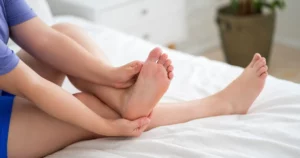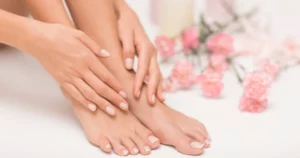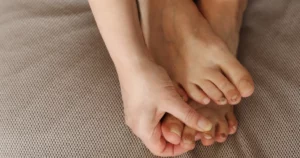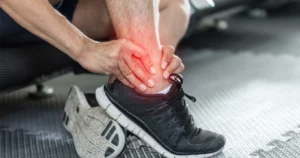
Table of Contents
Few things interrupt comfort faster than the sting of a sore toe when slipping into shoes. Many people in Elyria and Lorain, OH, suffer from corns. Some brush it off as a simple blister or irritation. Yet, that small patch of thickened skin could be a corn, a common but often misunderstood problem caused by repeated friction or pressure.
Corns in Elyria and Lorain, OH, don’t form overnight. They develop gradually as your skin tries to protect itself from ongoing irritation. Unfortunately, that protection often backfires, leading to pain, tenderness, and even inflammation. People who spend long hours on their feet, wear narrow or high-heeled shoes, or live active lifestyles frequently deal with them.
At Integrity Foot and Ankle Associates, many patients come in after trying to manage their corns at home. Treatment becomes far more effective once we identify the actual cause, whether it’s footwear, foot structure, or biomechanics.
Foot Corns Causes
Corns develop from repeated friction or pressure, but the triggers vary from person to person. Understanding these causes helps you make simple but effective changes.
Ill-Fitting Footwear
Shoes that are too tight squeeze the toes, forcing skin to rub against hard surfaces. Narrow toe boxes and high heels push the front of the foot into unnatural positions, leading to constant friction. On the other hand, shoes that are too loose let the foot slide, creating rubbing and irritation in new areas.
Rough seams, stitching, or internal bumps inside shoes can also press on specific spots, gradually creating a corn. Adjusting shoe size, style, or materials often makes a big difference.
Foot Structure and Biomechanics
Structural differences like hammertoes, claw toes, and bunions change how the foot bears weight. When one toe bends or rotates, it may press against another toe or the shoe’s upper surface. High arches and flat feet also shift pressure points, making certain areas more vulnerable.
Without proper support, these imbalances repeat with every step, leading to hard skin buildup where the most friction occurs.
Repetitive Activity and High Impact
Running, dancing, and other repetitive activities increase the pressure your toes and forefoot experience. Even walking long distances in unsupportive shoes can create enough rubbing to trigger corn formation. People who work on their feet all day, such as teachers, healthcare workers, or retail employees, often notice corns forming gradually over time.
Aging and Skin Changes
As the skin ages, it becomes thinner and less cushioned. Fat pads on the bottom of the feet shrink, leaving bones closer to the surface. With less protection, toes endure more direct friction inside shoes. Even mild pressure that once caused no problem can lead to painful corns.
Medical Conditions
Arthritis, diabetes, and neuropathy contribute to corns in different ways. Arthritis can deform joints, creating pressure points. Diabetes and neuropathy reduce sensation, making it harder to feel early irritation. Without pain as a warning, corns grow unchecked and sometimes develop into ulcers. Professional care helps prevent these complications.
Do you want to know more? Contact Integrity Foot and Ankle Associates Today! We aim to restore healthy movement and lasting comfort so you can stay active and pain-free.
Benefits of Toe Corn Treatment
Professional corn treatment offers more than just relief from pain. It helps restore normal function and prevents further complications. Many people notice immediate comfort after having the corn safely reduced or removed by a podiatrist.
Treating a corn professionally also helps prevent deeper tissue irritation. When pressure forces a corn inward, the constant friction can lead to open sores or infections if left alone. Prompt care stops this process early. You also regain natural movement.
Who Is This Best For?
Anyone with recurring pain or thickened skin on their toes or feet can benefit from corn treatment, but some groups are more susceptible. Adults between thirty and sixty tend to experience them more often because of cumulative wear, footwear habits, and changing skin texture.
People with structural differences in their feet, such as hammertoes, bunions, or claw toes, develop corns because these deformities change how pressure is distributed during walking. Even a slight misalignment can cause one toe to rub against another or against the top of a shoe.
What to Expect During Corn Treatment
Pre-Treatment Preparation
Your podiatrist begins with a conversation about your symptoms, footwear habits, activity level, and medical background. They’ll scrutinize your feet to pinpoint the cause of the pressure and identify any structural issues contributing to the problem.
It’s important not to attempt self-treatment before your appointment. Using blades or sharp tools to trim corns can break the skin and cause infection. Over-the-counter acid pads can burn surrounding tissue, especially in sensitive or diabetic skin. Let the podiatrist handle removal safely.
The Treatment Process
During the visit, your clinician softens the corn using a warm soak or moisturizing solution. Once the area is pliable, they gently pare away the thickened layers using sterilized instruments. The process is quick and typically painless.
After removal, your podiatrist evaluates your footwear and may recommend shoe modifications or padding to prevent recurrence. Pressure relief devices such as silicone toe sleeves or custom inserts redistribute weight and protect vulnerable spots.
If structural issues like hammertoes or bunions are involved, your provider might suggest orthotic inserts or specific shoe styles to correct the alignment and minimize rubbing.
Recovery and Aftercare
You can usually walk immediately after treatment. Your podiatrist may suggest wearing soft or open-toed shoes for a few days to avoid irritation. Keeping the skin moisturized and avoiding friction points is key to healing.
Results appear quickly. Pain often fades when the hardened area is reduced, and skin texture improves over the next week or two. The key to long-term success lies in addressing the root cause. The corn will return if the same shoes or activities continue creating pressure.
Frequently Asked Questions
What’s the difference between a corn and a callus?
A corn has a small, dense center that pushes inward, often causing pain. A callus covers a broader area and usually doesn’t hurt. Corns appear on or between toes, while calluses form on weight-bearing areas like the soles.
Why do my corns keep coming back?
Corns recur when the pressure or friction that caused them remains. The area thickens without adjusting shoes, foot support, or movement habits.
Are corns dangerous?
In healthy individuals, they’re rarely serious but can become painful or infected if ignored. In people with diabetes or anyone with poor circulation, corns pose real risks and need prompt attention.
Take Control of Your Foot Health
At Integrity Foot and Ankle Associates, we assess the actual cause behind each corn and create a plan to relieve pressure and prevent it from returning. Our care focuses on restoring comfort, protecting skin, and improving long-term foot function. Take control of your foot health—find out why corns develop and how to prevent them.




